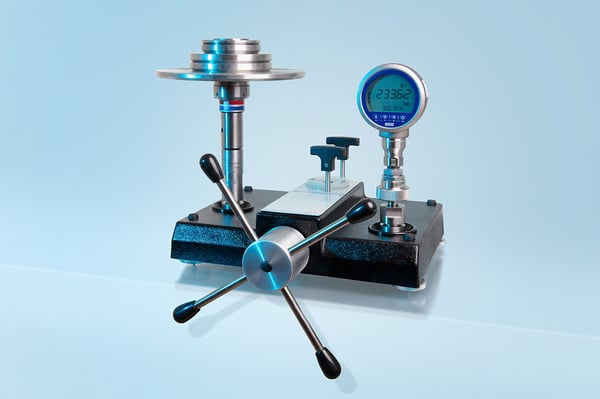Deadweight testers are available in a number of variants which makes choosing the right model for a particular application challenging.
Deadweight testers operate by generating pressure through compression of the media inside the base. The goal is to establish equilibrium between the known reference pressure and the DUT (Device Under Test). In this case, the known reference pressure is a piston-cylinder system stacked with physical calibrated weights. Once the medium is compressed to equilibrium, the piston will “float” and the DUT can be calibrated.
The pressure is equal to the force created by the weights, divided by the cross sectional area of the piston. By recording the readings from the DUT at various points of its measuring range, it is possible to ascertain if the accuracy is within the desired specification. Since the principle is based on the physics of balancing pressure at two sides, deadweight testers are also referred to as pressure balances.
 Deadweight Tester, Model CPB3800 pictured with CPG1500
Deadweight Tester, Model CPB3800 pictured with CPG1500
The biggest benefit of using deadweight testers is in their completely mechanical nature, which preserves the principles of measurements derived directly from SI units. This, in turn, means higher accuracies and traceability of measurements, making them the most widely known primary pressure reference standards.
The aim of this blog post is to describe some considerations that make the process of selecting the right deadweight tester much easier. Below are five things to take into account when choosing the right model for your application:
1. Area of Use
Onsite / Field Use
If considering a deadweight tester for field or onsite use like in power plants, maintenance facilities or other quality assurance processes, it's important to choose deadweight testers that offer a rugged and portable design, and work with pressure media that is compatible with DUTs in the field. Because deadweight testers do not require power, they are a good choice for remote field applications.
Laboratory Use
When using a deadweight tester in a calibration lab or a controlled environment, the accuracy specification of the instrument is one of the most important specifications. This class of deadweight testers (typically accuracies ranging from 0.008% to 0.002% of reading) will require monitoring of additional parameters, such as piston temperature, head height correction, local gravity correction, piston position, and other parameters that directly affect the accuracy of the reading. This could require the need for additional sensors to monitor these parameters, along with related computations to calculate the overall uncertainty of the calibration.
2. Choice of Media
The type of DUT, pressure range, and process connection drives the choice between gas media (pneumatic) or oil/water media (hydraulic).
Pneumatically-operated deadweight testers are capable of generating pressure in three distinct ways:
- Bidirectional (vacuum gauge) that can pump the system down to -14.5 psi (-0.95 bar).
- Gauge pressure using gas-operated, gas-lubricated pistons that are typically used for low to medium positive pressures up to 1500 psi (100 bar) maximum.
- Gauge pressure with oil-lubricated, pneumatic pistons. These are typically found in higher pressure pistons that have a very small diameter and require special oils to give them the lubrication needed for a frictionless passage through a cylinder. These enable calibration of pneumatic DUTs for higher pressures up to 7,250 psi (500 bar).
Additionally, some deadweight testers are set up in pairs or coupled in a single base to enable pneumatic or hydraulic differential pressure calibration.
3. Range
The operating range (typically 10-100% FS) should coincide with the operating range of the DUT. The range of a deadweight tester depends on the combination of the piston-cylinder system (measured in psi/kg or kN factor) and the corresponding minimum and maximum weight that can be used with this piston. Choosing the proper deadweight tester operating range will enable the user to calibrate the optimal number of DUTs with the highest possible accuracy. Another thing that could simplify the selection process is by choosing a dual piston mechanism that can enable two ranges within the same piston and mass set combination.
4. Accuracy
The test uncertainty ratio (TUR) drives the choice of which deadweight tester should be used for a particular application. In a typical scenario, the reference is at least four times more accurate than the DUT (4:1 TUR). For many applications, this is the most critical specification for the deadweight tester. Since these devices are primarily used as calibration reference standards, the accuracy specification will dictate the types of DUTs that can be calibrated. To get the best accuracy out of a deadweight tester, it is necessary to calculate the accuracy as a combination of the piston-cylinder system and the mass sets used together with the piston.
5. Starting Pressure
The starting pressure is defined as the minimum pressure that can be observed when the piston-cylinder system is floating without added weight. During a calibration, there will be a minimum and maximum pressure point that will be required. As noted earlier in the "Range" section, you must have an operating range that reaches the DUT's full scale value, but the minimum pressure requirement is often overlooked. It's important to ensure the deadweight tester can achieve the lowest point that will be required for the intended DUT ranges. Typically, a deadweight tester's minimum range is determined by the force applied through the weight of the piston-cylinder system without any additional mass sets. This weight determines the lowest starting pressure the deadweight can measure.
Conclusion
The optimal deadweight tester selection should be evaluated based on the area of use, range and accuracy class of the devices being calibrated, the operating pressure media required and the minimum starting pressure that is acceptable.
DH-Budenberg deadweight testers provide highly configurable industrial and laboratory models to fit your application with unmatched accuracy.
Related Reading:




